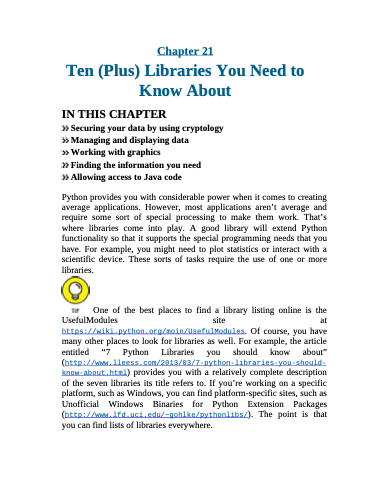Page 441 - Beginning Programming with Pyth - John Paul Mueller
P. 441
Chapter 21
Ten (Plus) Libraries You Need to Know About
IN THIS CHAPTER
Securing your data by using cryptology
Managing and displaying data Working with graphics
Finding the information you need Allowing access to Java code
Python provides you with considerable power when it comes to creating average applications. However, most applications aren’t average and require some sort of special processing to make them work. That’s where libraries come into play. A good library will extend Python functionality so that it supports the special programming needs that you have. For example, you might need to plot statistics or interact with a scientific device. These sorts of tasks require the use of one or more libraries.
One of the best places to find a library listing online is the UsefulModules site at https://wiki.python.org/moin/UsefulModules. Of course, you have many other places to look for libraries as well. For example, the article entitled “7 Python Libraries you should know about” (http://www.lleess.com/2013/03/7-python-libraries-you-should- know-about.html) provides you with a relatively complete description of the seven libraries its title refers to. If you’re working on a specific platform, such as Windows, you can find platform-specific sites, such as Unofficial Windows Binaries for Python Extension Packages (http://www.lfd.uci.edu/~gohlke/pythonlibs/). The point is that you can find lists of libraries everywhere.


